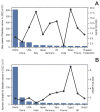New Challenges in Bladder Cancer Diagnosis: How Biosensing Tools Can Lead to Population Screening Opportunities
- PMID: 39771612
- PMCID: PMC11679013
- DOI: 10.3390/s24247873
New Challenges in Bladder Cancer Diagnosis: How Biosensing Tools Can Lead to Population Screening Opportunities
Abstract
Bladder cancer is one of the most common cancers worldwide. Despite its high incidence, cystoscopy remains the currently used diagnostic gold standard, although it is invasive, expensive and has low sensitivity. As a result, the cancer diagnosis is mostly late, as it occurs following the presence of hematuria in urine, and population screening is not allowed. It would therefore be desirable to be able to act promptly in the early stage of the disease with the aid of biosensing. The use of devices/tools based on genetic assessments would be of great help in this field. However, the genetic differences between populations do not allow accurate analysis in the context of population screening. Current research is directed towards the discovery of universal biomarkers present in urine with the aim of providing an approach based on a non-invasive, easy-to-perform, rapid, and accurate test that can be widely used in clinical practice for the early diagnosis and follow-up of bladder cancer. An efficient biosensing device may have a disruptive impact in terms of patient health and disease management, contributing to a decrease in mortality rate, as well as easing the social and economic burden on the national healthcare system. Considering the advantage of accessing population screening for early diagnosis of cancer, the main challenges and future perspectives are critically discussed to address the research towards the selection of suitable biomarkers for the development of a very sensitive biosensor for bladder cancer.
Keywords: biomarkers; bladder cancer diagnosis; lncRNA; population screening.
Conflict of interest statement
The authors declare no conflicts of interest.
Figures



Similar articles
-
Feasibility study of screening for bladder cancer with urinary molecular markers (the BLU-P project).Urol Oncol. 2010 Nov-Dec;28(6):686-90. doi: 10.1016/j.urolonc.2009.12.002. Urol Oncol. 2010. PMID: 21062653 Clinical Trial.
-
Urinary biomarkers in bladder cancer: A review of the current landscape and future directions.Urol Oncol. 2021 Jan;39(1):41-51. doi: 10.1016/j.urolonc.2020.08.016. Epub 2020 Sep 9. Urol Oncol. 2021. PMID: 32919875 Review.
-
Urine cytology. It is still the gold standard for screening?Urol Clin North Am. 2000 Feb;27(1):25-37. doi: 10.1016/s0094-0143(05)70231-7. Urol Clin North Am. 2000. PMID: 10696242 Review.
-
Screening for bladder cancer using urine-based tumor markers.Minerva Urol Nefrol. 2008 Dec;60(4):247-53. Minerva Urol Nefrol. 2008. PMID: 18923361 Review.
-
Precision screening with sequential multi-algorithm reclassification technique (SMART): Saving bladders from unnecessary cystectomy.Comput Biol Med. 2025 May;189:109980. doi: 10.1016/j.compbiomed.2025.109980. Epub 2025 Mar 9. Comput Biol Med. 2025. PMID: 40064121
Cited by
-
Accurate bladder cancer diagnosis using ensemble deep leaning.Sci Rep. 2025 Apr 15;15(1):12880. doi: 10.1038/s41598-025-95002-0. Sci Rep. 2025. PMID: 40234491 Free PMC article.
References
-
- Ferlay J., Ervik M., Lam F., Colombet M., Mery L., Piñeros M., Znaor A., Soerjomataram I., Bray F. Global Cancer Observatory: Cancer Today (Version 1.1) International Agency for Research on Cancer; Lyon, France: 2024. [(accessed on 15 November 2024)]. Available online: https://gco.iarc.who.int/today.
Publication types
MeSH terms
Substances
Grants and funding
LinkOut - more resources
Full Text Sources
Medical
Research Materials

